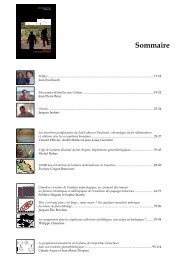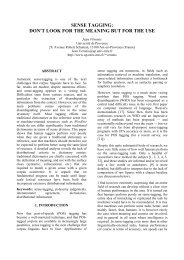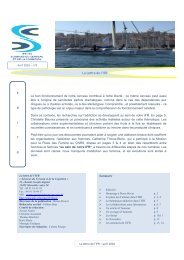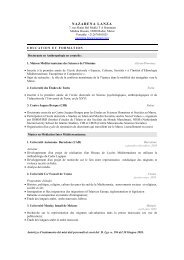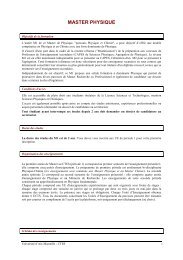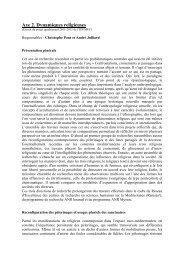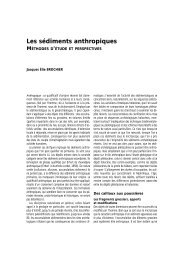Modelling of divertor plasma transport in stochastic magnetic boundary
Modelling of divertor plasma transport in stochastic magnetic boundary
Modelling of divertor plasma transport in stochastic magnetic boundary
You also want an ePaper? Increase the reach of your titles
YUMPU automatically turns print PDFs into web optimized ePapers that Google loves.
<strong>Modell<strong>in</strong>g</strong> <strong>of</strong> <strong>divertor</strong> <strong>plasma</strong> <strong>transport</strong><strong>in</strong> <strong>stochastic</strong> <strong>magnetic</strong> <strong>boundary</strong>M. KobayashiNational Institute for Fusion Science, Oroshi-cho 322-6, Toki city 509-5292, JapanIn acknowledgement <strong>of</strong> the fruitful discussions and contributions fromY. Feng, S. Morita, K. Ito, S. Masuzaki, T. Morisaki, N. Ezumi, S. Sakakibara, Y.Kikuchi, N. Ohyabu, T. Takizuka, S. Takamura, R. Burhenn, K.H. F<strong>in</strong>ken, M. Lehnen,D. Reiter, S.S. Abdullaev, M.Z. Tokar, Ph. Ghendrih, T. Kobayashi, Y. Narushima, F.Sardei, the LHD experimental groupITER International Summer School 2009, 22-26 June 2009, Aix en Provence, France1
Role <strong>of</strong> SOL <strong>plasma</strong> <strong>in</strong> fusion reactorConf<strong>in</strong>ement region:~10keV, 10 20 m -3 , α-particle conf<strong>in</strong>ement/heat<strong>in</strong>gcontrol <strong>of</strong> pressure/current pr<strong>of</strong>ile, 500MW fusion power, Q>10Power through LCFSImpurity, fuel <strong>in</strong>fluxScrape-<strong>of</strong>f layer:1~few hundreds eV, 10 20 ~10 21 m -3 , balance between // & l<strong>transport</strong>, power removal with radiation, impurity <strong>transport</strong>(material migration), <strong>plasma</strong> flow distribution, <strong>in</strong>teraction withneutralsPower/particle fluxFuel recycl<strong>in</strong>g, impurity sourceMaterial surface: <strong>divertor</strong> target, first wall<strong>plasma</strong> neutralization, erosion, deposition, fuel retention,heat removal & fuel/He ash pump<strong>in</strong>gFirstwallMaterialsurfaceDivertortargetConf<strong>in</strong>ementregionpumpSOL•Mitigation <strong>of</strong> power load on <strong>divertor</strong> plate•Reduction <strong>of</strong> Impurity <strong>in</strong>flux to conf<strong>in</strong>ement region•High pump<strong>in</strong>g efficiency <strong>of</strong> fuel, He ashITER International Summer School 2009, 22-26 June 2009, Aix en Provence, France2
MotivationStochastic field as a tool for controll<strong>in</strong>g edge <strong>plasma</strong>RMP for ELMs mitigationRMP reduces pressure gradient, <strong>in</strong>teractswith eigenmode structure <strong>of</strong> ELMse.g. Ergodic <strong>divertor</strong> <strong>in</strong>TEXT, Tore Supra,TEXTOR-DED etc. enhanced radial <strong>transport</strong>,edge radiation, impurityscreen<strong>in</strong>g etc.Intr<strong>in</strong>sic edge stochastization <strong>in</strong> Heliotron configurationUnderstand<strong>in</strong>g <strong>of</strong> <strong>plasma</strong><strong>transport</strong> characteristics <strong>in</strong><strong>stochastic</strong> field is <strong>in</strong>evitablefor <strong>divertor</strong> optimizationSymmetry break<strong>in</strong>g by Resonant Magnetic Perturbation2D axi-symmetric 3D non-axi-symmetricControllability <strong>of</strong> edge <strong>plasma</strong> for <strong>divertor</strong> optimizationITER International Summer School 2009, 22-26 June 2009, Aix en Provence, France3
Study on <strong>plasma</strong> <strong>transport</strong> <strong>in</strong> <strong>stochastic</strong> fieldMagnetic field structureIsland formaion, overlap (vacuum approximation) <strong>plasma</strong> response(field amplification, rotational screen<strong>in</strong>g, neoclassical effect)Measurements <strong>magnetic</strong> probe outside <strong>plasma</strong>, T epr<strong>of</strong>ileIdeal stochastization quasi-l<strong>in</strong>ear model, diffusive pictureRealistic field mixture <strong>of</strong> remnant islands, local ergodicfield, lam<strong>in</strong>ar regionContents <strong>of</strong> the talk1. Formation <strong>of</strong> <strong>magnetic</strong> island and <strong>stochastic</strong> field2. Realistic field structure <strong>in</strong> devices3. Effects on <strong>transport</strong> (3D treatment)--- <strong>divertor</strong> <strong>plasma</strong> parameters--- SOL impurity <strong>transport</strong>4. Summary--- further topics to be addressedTransport analysisAnalytical formulae(e.g. R-R model)// & l <strong>transport</strong> <strong>in</strong>terplay(3D treatment)Time averaged fieldEMC3-EIRENE, E3D, FINDIF etc.Fluctuat<strong>in</strong>g fieldElectrostatic/electro<strong>magnetic</strong>turbulence (P. Beyer et al.,DALF3) etc.ITER International Summer School 2009, 22-26 June 2009, Aix en Provence, France4
1. Formation <strong>of</strong> <strong>magnetic</strong> island and <strong>stochastic</strong> fieldITER International Summer School 2009, 22-26 June 2009, Aix en Provence, France5
= rs , ι = n /mFormation <strong>of</strong> <strong>magnetic</strong> island : vacuum fieldField l<strong>in</strong>es change their helicity <strong>in</strong> radialdirection because <strong>of</strong> <strong>magnetic</strong> shear.Δθ1 BθR 1ι ≡ = d =2 2∫ φπ π Bφr qd q<strong>magnetic</strong> shear: = q 'd rθrProjection ontoresonant surfaceRadial component <strong>of</strong> RMP B ~ r ( )resonates with field l<strong>in</strong>e helicity (m,n).~~ B r∝ cos( mθ − nφ )−5− 4B r/ B t= 10Island width~r q Bw = 4mθ-nφ=const.~ 10s rm , n~ several cmmq'BITER International Summer School θ 2009, 22-26 June 2009, Aix en Provence, FranceB ~ rwrResonantperturbationB ~rField l<strong>in</strong>es w<strong>in</strong>d around orig<strong>in</strong>al surface.6B ~ r2π/m
Onset <strong>of</strong> <strong>stochastic</strong> <strong>in</strong>stability by island overlapp<strong>in</strong>g: σ Chir > 1ι = n /( m + 1)Δnι =( m,m + 1)n / mWith <strong>in</strong>creas<strong>in</strong>g B ~ , islandrbecomes large.~w ∝ B r m, n/ ι'“overlap”? ?X-po<strong>in</strong>tO-po<strong>in</strong>tseparatrixσ Chir0.5( w + w2)( n,m)=Δ ( m,m + 1)n1>Island “overlaps”Field l<strong>in</strong>es <strong>in</strong> overlap region share Bfield with neighbor<strong>in</strong>g island, and“forget” from which island come from.1<strong>in</strong>creasesB ~ rw1 ( n,m + 1)w2 ( n,m )Stochastic trajectoriesITER International Summer School 2009, 22-26 June 2009, Aix en Provence, France7K.H. F<strong>in</strong>ken et al., “The structure <strong>of</strong> <strong>magnetic</strong> field <strong>in</strong> the TEXTOR-DED”
Field l<strong>in</strong>e structure <strong>in</strong> <strong>stochastic</strong> <strong>magnetic</strong> <strong>boundary</strong>Schematics <strong>of</strong> field l<strong>in</strong>e structureShort B l<strong>in</strong>esLong B l<strong>in</strong>esPerturbationcoil currentPerturbationfieldPFCsLam<strong>in</strong>ar region(edge surface layers)Connection length (L C) distribution <strong>in</strong> TEXTOR-DEDrφθRemnant islandsStochasticregionPoloidal turnsLam<strong>in</strong>ar region(edge surface layers)Stochastic regionShort & long L C coexistNo clear separatrix,locally ergodic, remnantislandsITER International Summer School 2009, 22-26 June 2009, Aix en Provence, Franceradialpoloidal8K.H. F<strong>in</strong>ken et al., PRL 98 (2007) 065001.
3. Effects on <strong>transport</strong> (3D treatment)ITER International Summer School 2009, 22-26 June 2009, Aix en Provence, France9
Magnetic field structure <strong>in</strong> LHD (Large Helical Device)Connection length (L C) distribution <strong>in</strong> poloidal cross sectionLHDHelical coils3.9 mITER International Summer School 2009, 22-26 June 2009, Aix en Provence, France10
3D modell<strong>in</strong>g <strong>of</strong> LHD edge region (EMC3-EIRENE)Computational mesh, configuration and <strong>in</strong>stallationsCore, CX-neutral <strong>transport</strong>, particle sourceSOL, EMC3 simulation doma<strong>in</strong>Vacuum <strong>of</strong> <strong>plasma</strong>*Physics model•Standard fluid equations <strong>of</strong> mass,momentum, ion and electron energy•Trace impurity fluid model (Carbon)•K<strong>in</strong>etic model for neutral gas (Eirene)Boundary conditions•Bohm condition at <strong>divertor</strong> plates•Power enter<strong>in</strong>g the SOL•Density on LCMS•Sputter<strong>in</strong>g coefficientCross-field <strong>transport</strong> coefficients•χ e=χ i=3D roughly holds•spatially constant (global <strong>transport</strong>)•determ<strong>in</strong>ed experimentallyITER International Summer School 2009, 22-26 June 2009, Aix en Provence, FranceSOLExample <strong>of</strong> LHDhelical <strong>divertor</strong>wallLCMSP SOLCore <strong>plasma</strong>C 0EMC3H,H 2Divertorlegs11target
Background <strong>plasma</strong> (fluid):∇⋅∇⋅∇⋅∇⋅UTzIITER International Summer School 2009, 22-26 June 2009, Aix en Provence, FranceModel equations <strong>in</strong> EMC3-EIRENE( nVi iIIb− Db⊥b⊥⋅∇ni) = Sp( m<strong>in</strong>Vi iIIViIIb−ηIIbb⋅∇ViII− mVi iIIDb⊥b⊥⋅∇ni−η⊥b⊥b⊥⋅∇ViII) = −b⋅∇p+ Sm55(2neTeViIIb−κebb⋅∇Te−2TeDb⊥b⊥⋅∇ne− χeneb⊥b⊥⋅∇Te) = −k( Te− Ti) +55( niTVi iIIb−κibb⋅∇Ti− TiDb⊥b⊥⋅∇ni− χ<strong>in</strong>ib⊥b⊥⋅∇Ti) = + k( Te− Ti) + SeizIi2Impurities (fluid):∇⋅z z zz( nIVIIIb− DIb⊥b⊥⋅∇nI)zz z( V −V) = −b⋅∇nTIIIb ⋅∇ne= TTieiII+ neeEIIeIeI2=S+ nzI+ n C b ⋅∇Tez−1→zZeE= 0− SNeutrals (k<strong>in</strong>etic):Boltzmann equation (Eirene code)+ nz→z+1zIZ2+ Rez+1→zC b ⋅∇Te− R+ nPlasma-surface and neutral-surface <strong>in</strong>teraction:Particle and energy reflection, sputter<strong>in</strong>g (Eirene code)IIz→z−1zIC b ⋅∇TiiSee+Simp12
φ=144 0 Vacuum vesselφ=153 0Field l<strong>in</strong>e aligned 3D gridsZ (m)Edge <strong>plasma</strong>R (m)Z (m)grid verticesφ 1φ 2φ 3φ 4φ 5B field l<strong>in</strong>eITER International Summer School 2009, 22-26 June 2009, Aix en Provence, FranceR (m)13
Fokker-Planck formJump step <strong>of</strong> Monte Carlo particle: e 3: e 1, e 2( : 1D and 2D random unit vectors)Monte Carloparticlee 2e 1e 3 = bB field l<strong>in</strong>eITER International Summer School 2009, 22-26 June 2009, Aix en Provence, France14
3. Effects on <strong>transport</strong> (3D treatment)3.1 <strong>divertor</strong> <strong>plasma</strong> parametersITER International Summer School 2009, 22-26 June 2009, Aix en Provence, France15
Role <strong>of</strong> pressure conservation along flux tubes on T div , n divn e, div(10 19 m -3 )Divertor <strong>plasma</strong> parameter <strong>in</strong> ASDEXSheath limitedregimeT i, divT e, divhigh recycl<strong>in</strong>gregime~ n−2~ nn e, div3DetachmentT e,i(eV)X-po<strong>in</strong>t <strong>divertor</strong> tokamaksPressure conservation along flux tube,∇// ( nT+ m<strong>in</strong>V//) =gives rise to sensitive <strong>divertor</strong> parameterdependence on upstream density :High recycl<strong>in</strong>g regime (conduction limited regime)ndiv ∝ n up320−2T div∝ n upThe dependence is experimentally confirmed.Stochastic <strong>boundary</strong>The 3D flux tube geometry can <strong>in</strong>troduceperpendicular terms break<strong>in</strong>g down <strong>of</strong> thepressure conservation.n e(10 19 m -3 )Y. Shimomura et al., NF 23 (1983) 869.∇2//( nT+ m<strong>in</strong>V//) − ∇⊥(mVi //D⊥∇⊥n+ η⊥∇⊥V//) =0ITER International Summer School 2009, 22-26 June 2009, Aix en Provence, France16
Parallel <strong>plasma</strong> flow is regulated by remnant island (mode) structureParallel flow distributionnV //10 23 /m 2 /s4.0radialB field l<strong>in</strong>es <strong>in</strong><strong>magnetic</strong> islandradialEdge surfacelayers2.00.0-2.0Core DivertornVnVnV //-nV //+~toroidal-4.0Flow projection ontopoloidal planepoloidalradialL Cdistributionpoloidal‣The field l<strong>in</strong>e structure produces flowalternation.‣Short conf<strong>in</strong>ement time <strong>in</strong> open fieldl<strong>in</strong>es leads to fast parallel flowimpact on impurity <strong>transport</strong>(discussed later)ITER International Summer School 2009, 22-26 June 2009, Aix en Provence, France17
Parallel <strong>plasma</strong> flow is regulated by remnant island (mode) structureradialradialEdge surfacelayersParallel flow distributionnV //10 23 /m 2 /s4.0Mach probe scann<strong>in</strong>g path2.00.0-2.0-4.010.50radialCore DivertorB field l<strong>in</strong>es <strong>in</strong><strong>magnetic</strong> islandnVnVnV //-Flow projection ontopoloidal planenV //+poloidalMach probe measurement~toroidalMach probe #1Mach probe #2Mach probe #33D modell<strong>in</strong>gL CdistributionpoloidalITER International Summer School 2009, 22-26 June 2009, Aix en Provence, France-0.5-1N. Ezumi et al, to appear <strong>in</strong> PFR.-0.95 -0.90 -0.85 18-0.80Z (m)
Parallel <strong>plasma</strong> flow is regulated by remnant island (mode) structureradialEdge surfacelayersParallel flow distributionl <strong>in</strong>teractionnV //10 23 /m 2 /s4.02.00.0‣The flow shear momentum loss <strong>of</strong>V //via l <strong>in</strong>teraction∇⊥( m iV// D ⊥∇ ⊥n + η ⊥∇ ⊥V//)-2.0-4.0Mach probe measurementn( T + T ) m nVe i+i2//10.5l <strong>in</strong>teractionMach probe #1Mach probe #2Mach probe #33D modell<strong>in</strong>g0-0.5-1N. Ezumi et al, to appear <strong>in</strong> PFR.l (m)//ITER International Summer School 2009, 22-26 June 2009, Aix en Provence, France-0.95 -0.90 -0.85 19-0.80Z (m)
Two po<strong>in</strong>t model with momentum loss <strong>in</strong> perpendicular direction10 0 -2T d~n uf m0=010 -1nd~nu3Tndd∝∝High recycl<strong>in</strong>g<strong>in</strong> tokamaks−2uf m0=0 110 1 1.5n ~nd u10 0(b)1 10n u(10 19 m -3 )ITER International Summer School 2009, 22-26 June 2009, Aix en Provence, Francenn3u(1 +(1 +1ffmm)88)2−3Increas<strong>in</strong>g f m0,T d~n u-1(a)fmD 1= ∫ ⊥u2m0//∇ nV//dl ≈ ∝0.5 0.5 22cdsdndcsdTdTdδm( Assumed D=const.)l//δ m−23T d∝ n u nd ∝ n u modest dependence on n uδ m : l characteristic length <strong>of</strong> the flow alternation: distance along field l<strong>in</strong>el //‣ f m0=0 high recycl<strong>in</strong>g <strong>in</strong> tokamaks‣Strong flux tube deformation large f m0, large momentum lossf m0>>1 −1T d∝ n u1.5nd ∝ n u20M. Kobayashi et al, to appear <strong>in</strong> JPFR (<strong>in</strong> Japanese), submitted to FS&T.fl
Divertor probe measurements confirm absence <strong>of</strong> high recycl<strong>in</strong>g regimeprior to detachmentTndd∝∝PP10 / 7SOL−8 / 7SOLnn−2u3u(1 +(1 +ffmm))2,−3High recycl<strong>in</strong>g<strong>in</strong> tokamaksDetach.‣Moderate dependence <strong>of</strong> T ed& n edon n u(T>10eV no significant CX loss,ν SOL*=L C/mfp>10)‣n ednever exceeds upstream density‣Both 3D modell<strong>in</strong>gs & the two po<strong>in</strong>t model(with P SOLvariation due to NBI heat<strong>in</strong>g<strong>in</strong>cluded) reproduce the experimental results. effect <strong>of</strong> momentum loss via l <strong>in</strong>teractionM. Kobayashi et al, to appear <strong>in</strong> JPFR (<strong>in</strong> Japanese),submitted to FS&T.ITER International Summer School 2009, 22-26 June 2009, Aix en Provence, France21
Momentum loss via friction between counter flows <strong>in</strong> W7-AS/XEMC3-EIRENEδ m ~60 cmn ed 10 19 m -3n ed~n u3δ ml //δ m ~8 cmfm∝Tl//0.5dδ2mn u 10 19 m -3Y. Feng et al., NF 46 (2006) 807, Y. Feng et al., submitted to NF.l //l //W7-AS: ~100 m, δ m ~8 cmW7-X: ~180 m, δ m ~60 cmfm,W 7− AS>>m,W 7−XfField l<strong>in</strong>e geometry near <strong>divertor</strong>, l//, δ m, provides controllability <strong>of</strong> <strong>divertor</strong> regime.ITER International Summer School 2009, 22-26 June 2009, Aix en Provence, France22
Summary <strong>of</strong> 3.1 Divertor <strong>plasma</strong> parameters1. nV //<strong>in</strong> <strong>stochastic</strong> <strong>boundary</strong> alternat<strong>in</strong>g flow regulated by remnant islands2. n div& T div<strong>in</strong> <strong>stochastic</strong> <strong>boundary</strong> <strong>of</strong> LHD show modest sensitivity to n up, <strong>in</strong> contrast to thehigh recycl<strong>in</strong>g regime <strong>in</strong> tokamaks.3. Breakdown <strong>of</strong> parallel pressure conservation via perpendicular frictional <strong>in</strong>teraction <strong>of</strong> thecounter flows.l//4. The degree <strong>of</strong> momentum loss can be described as fm∝0.5 2.Tdδm5. The analysis <strong>in</strong> W7-AS, X controllability <strong>of</strong> <strong>divertor</strong> regime:3nd ∝ n u1~1.5nd ∝ n u6. For future devices, l should be optimized for control <strong>of</strong> <strong>divertor</strong> <strong>plasma</strong> with <strong>stochastic</strong>//,δ m<strong>magnetic</strong> field.ITER International Summer School 2009, 22-26 June 2009, Aix en Provence, France23
3. Effects on <strong>transport</strong> (3D treatment)3.2 SOL impurity <strong>transport</strong>ITER International Summer School 2009, 22-26 June 2009, Aix en Provence, France24
3D impurity <strong>transport</strong> model : EMC3-EIRENE (fluid approximation)Momentum : // - Classical force balancemz1 Electric field∂ Vz//∂ T<strong>in</strong>zVi//− Vz//2 ∂ Te∂ T= − ++ ZeE 0.71 2.62 imz//+ Z + Z + ....∂ t n ∂ s τ∂ s ∂ szsτsImpuritypressuregradient forcefriction∂ T∂ sFriction±V Z //?electron & ion temperature gradient force(thermal force)LCFST iThermaldT i/dsMass : | - Diffusion with anomalous coefficientr r r r r∇⋅=S( n V b − D b b ⋅∇n)zz //z−1→znz−1z− S⊥⊥z→z+1nzz+ Rz+1→znz+1− Rz→z−1nzcoreRecycl<strong>in</strong>gFrictionSOLV iIItargetsD z is set to be the same value <strong>of</strong> bulk <strong>plasma</strong>that is deduced from experiments.ITER International Summer School 2009, 22-26 June 2009, Aix en Provence, France25
From thermal-force to friction-dom<strong>in</strong>ated impurity <strong>transport</strong>Plasma ionflow nv II3×10 19Thermal force dom<strong>in</strong>ant <strong>in</strong>ward flowCarbon density distributionImpurity flown LCMS=2×10 19 m -3Increase n e(10 18 m -3 )1.00.1Impurity flow4×10 190.01friction dom<strong>in</strong>antITER International Summer School 2009, 22-26 June 2009, Aix en Provence, Franceoutward flow26
Carbon density pr<strong>of</strong>iles by 3D model show impurity retention at high density5.03.01.00.800.600.40n LCFS=1.5x10 19 m -32.0x10 193.0x10 196.0x10 1910 21 Impurity ionization (s -1 m -3 )10 190.80.60.40.2Acceleration<strong>of</strong> //-<strong>plasma</strong>flowthermalfriction642Increas<strong>in</strong>g density Enhances friction force <strong>in</strong> edge surfacelayer with flow acceleration by short flux tubes Stops carbon penetration <strong>in</strong> edge surface layers Feels more friction Suppresses thermal force <strong>in</strong> <strong>stochastic</strong>region0.60Stochasticregion0.650.70Edge surfacelayersr eff(m)L C/m10 510 410 310 20.00.60 0.65 0.70r eff(m)StochasticEdge surfaceITER International Summer School 2009, 22-26 June 2009, Aix en Provence, France010 110 027
3D code predicts that energy <strong>transport</strong> follows the remnant island structure strong modulation <strong>of</strong> Te distributionL C/mT e/eVr 10 5 10 4 10 3 10 2 10 1 10 0eff(m)200 100 00.70Edge surfacelayersEMC3-EIRENE0.650.60StochasticregionInboardOutboardInboardClear mode structure is observed <strong>in</strong> Tepr<strong>of</strong>iles obta<strong>in</strong>ed by Thomson scatter<strong>in</strong>gsystem <strong>in</strong> good agreement with the code result.ITER International Summer School 2009, 22-26 June 2009, Aix en Provence, FranceT e/ eV* ThomsonEMC3/EIRENEn/m=10/310/510/72.5 2.6 2.7 2.8 2.9 3.028R/m
Key role <strong>of</strong> remnant islands on impurity <strong>transport</strong>∂ Ti2.5qr= −nχ⊥ − b ⋅ rκi0Ti∇//∇//Ti∂ r= −nχr⊥rqri0//Θ+ κ T2.5iWith high density & small Θ (~10 -4 <strong>in</strong> LHD),Θ2Tiκwnχ⊥2.5i0T i>> Θ2l //|-<strong>transport</strong> dom<strong>in</strong>atesbrr rΘ = b ⋅(Y. Feng NF 46 2006)≈wl //∇//Ti≈ −qrnχΘ⊥∝n−1Increas<strong>in</strong>g density suppresses //-T gradient, i.e.thermal force <strong>in</strong> the presence <strong>of</strong> remnant islands.ITER International Summer School 2009, 22-26 June 2009, Aix en Provence, France29M. Kobayashi et al., Proceed<strong>in</strong>gs <strong>of</strong> 22nd IAEA FEC (2008) EX/9-4.
Radial pr<strong>of</strong>iles <strong>of</strong> each charge states <strong>of</strong> carbon densityImpurity screen<strong>in</strong>g shift <strong>of</strong> impurity density pr<strong>of</strong>ile to low temperature regionImpurity screen<strong>in</strong>g10 18n up=2e19 m -3Z ≥ +4 Z ≤ + 310 18n up=4e19 m -3Z ≥ +4 Z ≤ + 3n z(m -3 )10 17C+6C(all)C+4C+5C+1C+2n z(m -3 )10 17C(all)C+4C+5C+6C+1C+2C+310 16C+310 1610 15 r eff(m)0.60 0.65 0.70r eff(m)10 150.60 0.65 0.70r eff(m)r eff(m)ITER International Summer School 2009, 22-26 June 2009, Aix en Provence, France30
CIII: 977Å, 1S 2 2S 2 -1S 2 2S2P (VUV monochromators)CIV: 1548Å, 1S 2 2S-1S 2 2P (VUV monochromators)CV: 40.27Å, 1S 2 -1S2P (EUV spectrometer)(a)Emission measurements <strong>in</strong> experiments <strong>in</strong>dicateimpurity retention potential at high densityCIII/neCIV/neCV/ne10 2View<strong>in</strong>g areaSpectroscopyAbsolutely calibrated10 1<strong>Modell<strong>in</strong>g</strong>10 0 0 2 4 6 8CIII radiation distribution <strong>in</strong> thesame view<strong>in</strong>g area obta<strong>in</strong>ed by3D code.10 -1ExperimentsITER International Summer School 2009, 22-26 June 2009, Aix en Provence, Francen e(e19 m -3 )31
Signature <strong>of</strong> impurity screen<strong>in</strong>g with <strong>stochastic</strong> <strong>boundary</strong> various devicesTore SupraY. Corre et al., NF 47 (2007) 119. TEXTOR-DEDG. Telesca et al., JNM 390-391 (2009) 227.Carbon flux and densityC 6+ concentrationwith DEDDEDcurrentwithout DEDHigh densityC 6+ density <strong>in</strong> conf<strong>in</strong>ement regiondecreases with <strong>in</strong>creas<strong>in</strong>g density.time (s)C 6+ concentration <strong>in</strong> core regiondecreases with DED activation.ITER International Summer School 2009, 22-26 June 2009, Aix en Provence, France32
Summary: SOL Impurity <strong>transport</strong>1. 3D impurity <strong>transport</strong> modell<strong>in</strong>g <strong>in</strong> the <strong>stochastic</strong> <strong>magnetic</strong> structure shows impurity screen<strong>in</strong>geffect at high density :Increas<strong>in</strong>g density Enhances friction force <strong>in</strong> edge surface layer with flow acceleration by rich ionizationsource Stops carbon penetration <strong>in</strong> edge surface layers Feels more friction Suppresses thermal force <strong>in</strong> <strong>stochastic</strong> regionnχ⊥22. The remnant islands with small Θ ( ≈ w / l ) , >> Θ//2.5and high density κi0T ii.e. suppression <strong>of</strong> thermal force at high density∇//T∝ n−13. The edge carbon emission measurements agree well with the code results, <strong>in</strong>dicat<strong>in</strong>g impurityretention effect <strong>of</strong> <strong>stochastic</strong> <strong>magnetic</strong> <strong>boundary</strong>.ITER International Summer School 2009, 22-26 June 2009, Aix en Provence, France33
SummaryPlasma <strong>transport</strong> <strong>in</strong> <strong>stochastic</strong> <strong>magnetic</strong> <strong>boundary</strong> <strong>in</strong> LHD is analyzed by the 3D edge<strong>transport</strong> code <strong>in</strong> comparison with experimental results and with other devices.1. Magnetic shear + RMP topological change <strong>of</strong> field l<strong>in</strong>es (<strong>magnetic</strong> island), <strong>stochastic</strong> <strong>in</strong>stability l , // characteristic scale: δ m, w, l//2. Influence on <strong>divertor</strong> regime:l//high recycl<strong>in</strong>g no high recycl<strong>in</strong>g with fm∝0.5 2Tdδmnχ⊥3. Impurity screen<strong>in</strong>g potential at high density with very small Θ ( ≈ w / l//) ,κi0T and flow acceleration <strong>in</strong> edge surface layers (lam<strong>in</strong>ar region).i2.5>> Θ2These geometrical parameters provide control <strong>of</strong> edge <strong>plasma</strong> <strong>transport</strong> <strong>in</strong> <strong>stochastic</strong> SOL.Stochastic <strong>magnetic</strong> boundariesSymmetry break<strong>in</strong>g Controllability <strong>of</strong> edge <strong>plasma</strong> <strong>transport</strong>ITER International Summer School 2009, 22-26 June 2009, Aix en Provence, FranceFurther topics to be <strong>in</strong>vestigatedPower load dispersal on <strong>divertor</strong> platesPlasma response to RMP.Electric field formation, determ<strong>in</strong>ation <strong>of</strong> D,D Z, χ.Quantitative estimation for future devices34
Field l<strong>in</strong>es connect <strong>divertor</strong> plate with different connection lengths(ranges <strong>in</strong> two orders, 10 m ~ 1000 m)l0rδ 0‣Magnetic shear + B ~r stretch<strong>in</strong>g, bend<strong>in</strong>g, compression <strong>of</strong> flux tubesl (s)Magnetic shearδ (s)B ~ rL C pr<strong>of</strong>iles on <strong>divertor</strong> platesL C (m)The long & short flux tubesare mixed due to thedeformation, creat<strong>in</strong>g f<strong>in</strong>estructure.blow upNot only //, BUT l energyexchange between fluxtubes plays important role<strong>in</strong> determ<strong>in</strong><strong>in</strong>g wetted area.~4 cmITER International Summer School 2009, 22-26 June 2009, Aix en Provence, France35
3D <strong>Modell<strong>in</strong>g</strong> : Power deposition pr<strong>of</strong>ile <strong>in</strong>sensitive to P SOLPROBE10.5U_P02_D0.50_1.50_NUP41.00.8λ p2MW4MW8MW16MW0.60.40.2Δ energy0.00.06 0.08 0.10 0.12 0.14s (m)Maximum power load l<strong>in</strong>early scales with P SOL,<strong>in</strong>dicat<strong>in</strong>g no P SOLdependence <strong>of</strong> Δ energy.Because <strong>of</strong> Δ energy>> λ p, change <strong>of</strong> λ pis negligible.ITER International Summer School 2009, 22-26 June 2009, Aix en Provence, France36
IR camera measurements <strong>in</strong> TEXTOR-DED:Divertor heat flux is well correlated with L C distributionHeat flux (W/m 2 )Connection length (poloidal turns)M. Jakubowski et al., PPCF 49 (2007) S109.ITER International Summer School 2009, 22-26 June 2009, Aix en Provence, France37
Plasma response to RMP : screen<strong>in</strong>g/amplification by current <strong>in</strong>ducedaround resonance surfaceSk<strong>in</strong> effectPlasmarotationB ~rRMP coilShield<strong>in</strong>gcurrentI pTear<strong>in</strong>g mode<strong>in</strong>stabilitycoilB ~r~ plj φcoilB ~ rY. Kikuchi et al. NF 44 (2004) S28.ITER International Summer School 2009, 22-26 June 2009, Aix en Provence, France38
Neo-classical effect : bootstrap current, polarization currentIsland heal<strong>in</strong>gIsland heal<strong>in</strong>gITER International Summer School 2009, 22-26 June 2009, Aix en Provence, FranceY. Narushima et al., Nucl. Fusion 48 (2008) 075010.N. Ohyabu et al., Phys. Rev. Lett. 88 (2002) 055005.39K. Itoh, S.I. Itoh and M. Yagi, Phys. Plasmas 12 (2005) 072512.
Possibility for stable detachment control with remnant island structureStrong radiation is localized at the remnant island structureY. Feng et al., NF 48 (2008) 024012.ITER International Summer School 2009, 22-26 June 2009, Aix en Provence, France40
Interaction <strong>of</strong> island cha<strong>in</strong> <strong>of</strong> different modes at high field region leads to strongflow shear Momentum loss via cross-field friction-4.0 -2.0Helical coilHFRnV // (10 23 1/m 2 /s)0LFR2.04.0radialCore Divertorm=6 mode (even)m=7 mode (odd)poloidalnV //-Flow shearnV //+toroidalHFRHelical coiln( T + T ) m nVe i+i2//ZLFR~ 6cmRITER International Summer School 2009, 22-26 June 2009, Aix en Provence, Francel (m)//41
Parallel <strong>plasma</strong> flow is regulated by remnant island (mode) structureradialEdge surfacelayersParallel flow distributionnV //10 23 /m 2 /s4.0Mach probe scann<strong>in</strong>g path2.00.0-2.0‣The field l<strong>in</strong>e structure produces flowalternation.‣Short conf<strong>in</strong>ement time <strong>in</strong> open fieldl<strong>in</strong>es leads to fast parallel flow,Mach>0.5impact on impurity <strong>transport</strong>(discussed later)radialCore DivertorpoloidalB field l<strong>in</strong>es <strong>in</strong><strong>magnetic</strong> islandnVnVnV //-Flow projection ontopoloidal planenV //+poloidal~toroidalITER International Summer School 2009, 22-26 June 2009, Aix en Provence, France-4.010.50-0.5-1Mach probe measurementMach probe #1Mach probe #2Mach probe #33D modell<strong>in</strong>gN. Ezumi et al, to appear <strong>in</strong> PFR.-0.95 -0.90 -0.85 -0.8042Z (m)
Parallel <strong>plasma</strong> flow is regulated by remnant island (mode) structureradialEdge surfacelayersParallel flow distributionl <strong>in</strong>teractionnV //10 23 /m 2 /s4.02.00.0‣The flow shear momentum loss <strong>of</strong>V //via l <strong>in</strong>teraction∇⊥( m iV// D ⊥∇ ⊥n + η ⊥∇ ⊥V//)-2.0radialpoloidalB field l<strong>in</strong>es <strong>in</strong><strong>magnetic</strong> island-4.010.5Mach probe measurementl <strong>in</strong>teractionMach probe #1Mach probe #2Mach probe #33D modell<strong>in</strong>gCore DivertornVnVnV //-Flow projection ontopoloidal planenV //+poloidal~toroidalITER International Summer School 2009, 22-26 June 2009, Aix en Provence, France0-0.5-1N. Ezumi et al, to appear <strong>in</strong> PFR.-0.95 -0.90 -0.85 -0.80Z (m)43
What we have learnedSummary <strong>of</strong> 3.1 Divertor <strong>plasma</strong> parameters1. nV //<strong>in</strong> <strong>stochastic</strong> <strong>boundary</strong> alternat<strong>in</strong>g flow regulated by remnant islands2. n div& T div<strong>in</strong> <strong>stochastic</strong> <strong>boundary</strong> <strong>of</strong> LHD show modest sensitivity to n up, <strong>in</strong> contrast to thehigh recycl<strong>in</strong>g regime <strong>in</strong> tokamaks.3. Breakdown <strong>of</strong> parallel pressure conservation via perpendicular frictional <strong>in</strong>teraction <strong>of</strong> thecounter flows.l//4. The degree <strong>of</strong> momentum loss can be described as fm∝0.5 2.Tdδm5. The analysis <strong>in</strong> W7-AS, X controllability <strong>of</strong> <strong>divertor</strong> regime:3nd ∝ n u6. For future devices, l should be optimized for control <strong>of</strong> <strong>divertor</strong> <strong>plasma</strong>.//,δ me.g. for good neutral compression, f mshould be small.ITER International Summer School 2009, 22-26 June 2009, Aix en Provence, France1~1.5nd ∝ n uWhat we haven’t yet understood1. If D has parameter dependence, f m(n d, T d) ? affects qualitative dependence!!l//2. If l momentum flux is not ∝ ∇ ⊥nV //, but convective one ∝V ⊥ , convV //then fm∝ ?δm affects quantitative dependence!44
What we haven’t yet understoodSummary: SOL Impurity <strong>transport</strong>1. Parameter & Z dependence <strong>of</strong> ? affects quantitative dependence!ΘD Z ⊥VZ //+ V Z , conv2. l convective term ? affects qualitative dependence!!Simplified // force balance between frictionand ion thermal force reads,τZi 2VZ //= Vi//+ CiZ ∇//mZTi1D radial cont<strong>in</strong>uity,d ⎛⎜ΘnZVdr ⎝∑Z→Z //− DZ ⊥dnd ⎛⎜ΘnIVdr ⎝drZZ //⎞⎟⎠−= −SDZ ⊥Zdndr− RI⎞⎟⎠Z+ S= 0Z −1+RZ + 1Solution for target-released impurities:nItarget⎛⎞⎜ΘVZ//= −⎟, LCMS/ nI, t arg etexp∫ dr⎝ DLCMS Z ⊥ ⎠ITER International Summer School 2009, 22-26 June 2009, Aix en Provence, FrancennI , LCMSI , t arg etLCMSV Z //>V Z //
ITER International Summer School 2009, 22-26 June 2009, Aix en Provence, France46
Simple 1D model~P SOL5/91.03D results0.10 5 10 15 20P SOL(MW)ITER International Summer School 2009, 22-26 June 2009, Aix en Provence, France47




